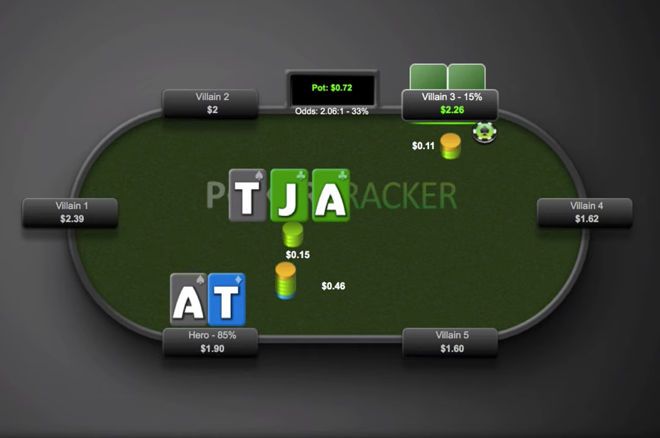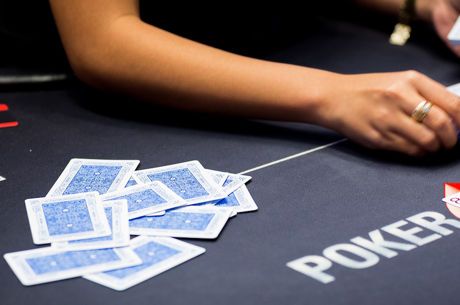Are You Trapping Yourself in Poker? Avoid This Common Mistake

When we think about setting a poker trap, we often think about flopping a big hand and then playing it slow to trick our opponent. This can be a good strategy sometimes, depending on the board texture and the players involved in the hand with you.
But what about trapping yourself at the poker tables? Yes, this actually is a thing! And it is a big mistake that I see a lot of beginners making especially.
Here is a hand that demonstrates a good example of a player trapping himself:
In this poker hand from a micro stakes 6-max. online game we raise preflop with A?10? from early position. Now I have to say that normally this is just a routine fold for me. I don't think that generally we need to be playing this hand from this position.
The problem with this hand is that we could get called or raised by somebody behind with a better hand or one that dominates us (e.g., A-K, A-Q, A-J). Even more importantly, if we do get to postflop we will likely have to play the hand from out of position.
The Power of Position
As I talk about in Crushing the Microstakes, the two key pillars to success in poker are initiative and position.
Initiative basically refers to raising preflop and having the betting lead. We did that already in this hand, so that is great. However, we are unlikely to have position in this hand going forward, meaning that we will have to act first after the flop.
Statistically speaking, playing from out of position is a huge disadvantage in poker. You will make far more money when you are in position and therefore get to act last after the flop. This is why I highly recommend that you have a tighter starting hand selection range when playing from early position, middle position, and the blinds.
Conversely, if we were in the cutoff seat or the button in this hand, then it is a totally different story. You absolutely should be playing this hand from those seats.
Why? Again, it is all about position. From the cutoff and button we are very likely to get to act last after the flop. As mentioned, this is a huge advantage in poker and therefore we can afford to play a lot more hands profitably from these two seats especially.
Assessing Your Hand Strength Correctly on the Flop
In this hand only the button calls, and the flop comes pretty favorably for us �� 10?J?A?.
We have top and bottom pair. In most cases in no-limit hold'em, that's a very strong hand with which you want to play a big pot. However, this situation is a little bit different, because this flop board texture is extremely wet and coordinated. There are made hands that already beat us such as a straight or a better two pair, and there are also several big draws that have a ton of equity against us �� e.g., hands like 9?8?.
For these reasons, I would suggest taking the standard line in this hand by simply making a continuation bet on the flop. Our opponent is going to either call, fold, or raise.
If he decides to call, no problem. This means that he probably has a draw and we can continue to keep applying pressure depending on the turn card. If he decides to fold to our continuation bet, well, that is of course fine as well. We will just take the pot down. Nice!
Meanwhile if our opponent decides to raise our continuation bet, then we can just call and reevaluate on the turn. This allows us to control the size of the pot and not commit ourselves to playing a big hand just yet.
Don't Trap Yourself by Check-Raising
Another option in this hand is to check-raise, which is what we actually decided to do. But the problem with this decision is that we essentially end up trapping ourselves.
This is because, as I mentioned before, this is a very wet and coordinated board. And while we have a very good hand, we do not have the nuts or best hand possible.
When you decide to take a check-raise line in poker, you almost always want to be doing it either with the absolute nuts or as a bluff with a weak draw. You do not want to use a check-raise line when you have a middle of the road or even a good hand like we do. The reason why is because we do not want to play a big pot with hands like this.
We end up trapping ourselves in this situation because we often only get action from hands that beat us and we fold out all the hands that we beat. I often refer to this as a "lose-lose" situation in poker. We don't win at poker by putting ourselves in spots like this. We win at poker by finding win-win situations instead.
You trap yourself in poker when the action that you take in the hand only gets you action from hands that beat you and folds out all the bluffs or hands that you beat. That's why the best course of action in this hand is just to take the standard line of betting the flop.
This really just boils down to assessing the strength of your hand properly on the flop. We do not have the nuts here. We have a good hand, but not the nuts. Therefore, we do not want to take a check-raise line and trap ourselves.
I want to know what you think, though. Let me know your thoughts on this hand in the comments below. Do you ever trap yourself at the poker tables?
Link mentioned in the video:
Nathan "BlackRain79" Williams is a poker pro and the author of the popular micro stakes strategy books Crushing the Microstakes, Modern Small Stakes, and The Microstakes Playbook. He also blogs about how to beat the micro stakes over at www.blackrain79.com.









